Welcome to “Tips From Sticks-In-The-Mud Woodshop.” I am a hobbyist who loves woodworking and writing for those who also love the craft. I have found some ways to accomplish tasks in the workshop that might be helpful to you, and I enjoy hearing your own problem-solving ideas. Please share them in the COMMENTS section of each tip. If, in the process, I can also make you laugh, I have achieved 100% of my goals.
“This call may be monitored and recorded for better customer service.” Apparently, it’s true. Ever the frugal consumer, when a battery company puts a guarantee on their packaging that says they will repair or replace equipment damaged by battery leakage, I found out they do keep track of those claims. How? One day, I got this notice in the mail:
Dear Mr. Randolph,
In covering our batteries’ warranty to repair or replace items damaged by leakage, we have reimbursed you many times for electronics you have sent us. Along with cash reimbursements, we have included coupons for free batteries, redeemable through local merchants.
Each time, we have advised you to be sure to change batteries prior to their expiration date, and to quickly remove batteries when their charge is exhausted. Your latest warranty submission contains leaky batteries that are far beyond their printed expiry.
Unfortunately, we are unable to continue to provide warranty protection when the end user repeatedly ignores proper battery use instructions. In gratitude for your loyal use of ‘XXX’ batteries, we have enclosed your ruined radio and coupons with which you may obtain new ‘XXX’ batteries.”
I now use two techniques to prevent having electronics become ruined by leaky batteries.
One, I put a reminder in my computer (a phone reminder would work just as well) that tells me to change the batteries in certain equipment every-so-often. Each piece of equipment has its own reminder. By dating the batteries as they are installed in each piece, I am able to determine how long the battery will last in that particular item.
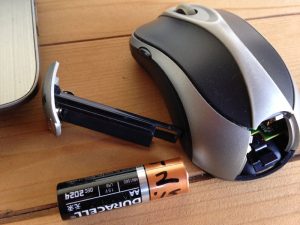
Every battery-powered thing I own has dated batteries. It’s easy to tell when batteries have gotten old.
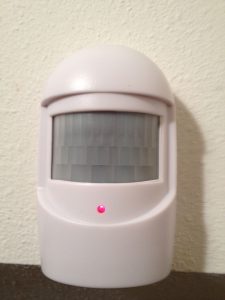
Dates on the AA batteries in this transmitting shop monitor have shown me, over time, that they will last about 8 months. A computer reminder tells me to change the batteries before they discharge and leak, ruining the device.
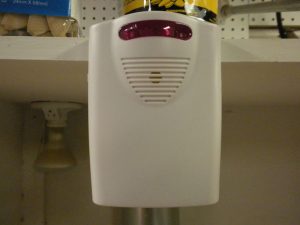
By contrast, the receiving half of the same unit has an internal monitor that turns on a light when its 9-volt battery is low. Why can’t everything be like that?
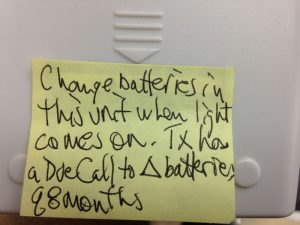
I don’t need a battery-changing reminder for the receiver, but I do need a Post-It Note reminder to tell me why I don’t need a reminder.
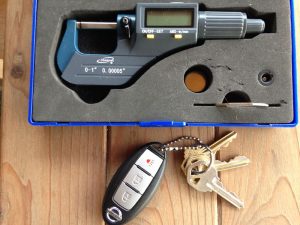
My Nissan key fob, this micrometer, the microphones in the breathing monitors at our clinic and the glucose meter all use the same button battery. I keep one brand new battery in the clinic and one in the car, always ready, rather than each item having its own standby, with all of them getting older, and weaker.
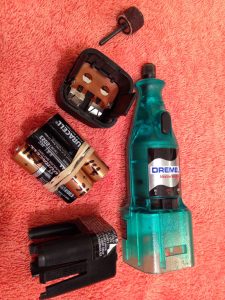
I don’t use this little battery-powered Dremel much, but when no wall power is available, or in wet locations, it’s mighty handy. It takes less than a minute to slide the batteries back into their holster and into the Dremel.
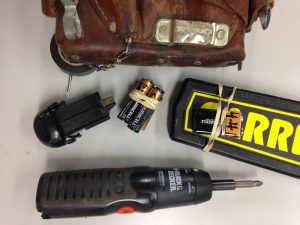
Months often go by that I don’t need to use the metal detector. Therefore, I take the battery out every time I use it. Ditto for the electric screwdriver in the electrical belt.
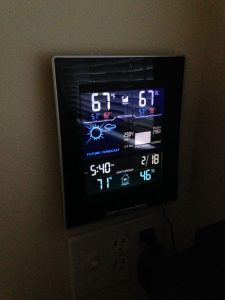
Some items need to have their batteries in all the time, especially devices requiring battery backup. For the bedside clock and weather station, we have computer reminders to change the batteries before they can go bad.
Return to the March 2017 issue of Wood News Online
Jim Randolph is a veterinarian in Long Beach, Mississippi. His earlier careers as lawn mower, dairy farmer, automobile mechanic, microwave communications electronics instructor and journeyman carpenter all influence his approach to woodworking. His favorite projects are furniture built for his wife, Brenda, and for their children and grandchildren. His and Brenda’s home, nicknamed Sticks-In-The-Mud, is built on pilings (sticks) near the wetlands (mud) on a bayou off Jourdan River. His shop is in the lower level of their home.Questions and comments on woodworking may be written below in the comments section. Questions about pet care should be directed to his blog on pet care, www.MyPetsDoctor.com. We regret that, because of high volume, not all inquiries can be answered personally.


I have had so many of the XXX brand batteries that look exactly like your pictures (wink wink) that I have given up. What took the cake is that I had indeed removed the battery from the device, as directed, and it leaked all over a cabinet, leaving a big stain.
I now use either Eneloop or Imedion rechargeable low discharge Ni-MH batteries and have no problems. Get a good charger / conditioner that can charge each cell individually. Imedion’s manufacturer makes a couple. I have also used Tenergy but don’t find them as good.
I buy them in packs from Thomas distributing and the pricing is good.
Two benefits are long term cost is lower and all those batteries don’t end up in the landfill.
There are newer Ni-MH batteries marketed for cameras that have a lower self discharge rate.
“Regular” Ni-MH batteries will go flat in about a month sitting on the shelf.
These low discharge batteries retain about 80% charge after 6 months.
One drawback is a slightly lower mAh rating, but for occasional use tools, it’s an acceptable trade-off. I use these in my cameras and emergency radios.
Use rechargable batteries in everything I can get them for. Otherwise no problem except some flashlights and the once I put regular batteries in a rechargable headphone then put it in its charging cradle….need I say more.
For expensive equipment, or those items which are very rarely used, I use a lithium cell, available in AA, and AAA. These are considerably more expensive than alkaline batteries, but they do not corrode, last longer, and continue to work in cold weather. Also good in my attic (hot and cold) water sensor for my water heater.
For frequently used items, I agree with Gerald that rechargeable NiMH batteries are a good solution.